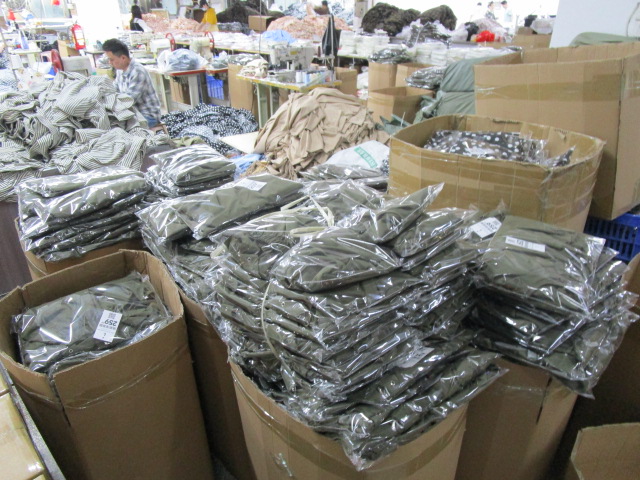
Are you sourcing products from China? Do you find yourself concerned about the quality of goods from Chinese suppliers? If so, this article is tailored just for you.
Quality assurance is paramount when it comes to importing goods from China. One crucial aspect of ensuring product quality and compliance with standards is pre-shipment inspection. This process plays a vital role in identifying and addressing potential issues before products leave the manufacturing facility and are shipped to customers worldwide.
In this article, we’ll delve into the world of pre-shipment inspection in China, exploring its significance, procedures, and how it contributes to maintaining high-quality standards for exported goods. Whether you’re a seasoned importer or new to sourcing from China, understanding pre-shipment inspection practices can greatly benefit your business and mitigate risks associated with quality control.

Contents
- 1 What is Pre-Shipment Inspection?
- 2 Procedures for Pre-Shipment Inspection
- 3 Inspection report of Pre-shipment inspection
- 4 Who can perform pre-shipment inspection services in China?
- 5 Pre-shipment Inspection vs. Random Inspection
- 6 Pre-shipment Inspection:
- 7 Random Inspection:
- 8 Pre-shipment Inspection vs. 100% Inspection
- 9 What type of inspection is most suitable for me?
- 10 If my pre-shipment inspection report shows a failed result, how should I handle it?
What is Pre-Shipment Inspection?
Pre-Shipment Inspection (PSI) is a quality control process aimed at ensuring that products meet specific quality standards and customer requirements before they are shipped. The inspection can be conducted at the supplier’s factory, a freight forwarding warehouse, or a customs warehouse. This inspection is typically conducted by a third-party quality inspection agency or appointed inspectors when production is at least 80% complete and the goods are ready for shipment. The primary purpose of pre-shipment inspection is to conduct a comprehensive examination and assessment of the products to promptly identify and rectify any potential quality issues or defects, thereby preventing non-compliant products from entering the market or reaching the hands of customers.
The inspection covers various aspects of the product, including appearance, dimensions, functionality, performance, packaging, etc., Inspectors sampling from completed goods according to the international standard (ISO 2859/MIL-STD-105E), then check each sample individually, and based on the Acceptable Quality Level (AQL), determine whether the entire batch is passed, pending, or failed. Pre-Shipment Inspection can also be conducted as a full inspection (100% inspection).
Procedures for Pre-Shipment Inspection
Pre-shipment inspection plays a critical role in ensuring that products meet specified quality standards before they are shipped to customers. The detailed procedures for conducting pre-shipment inspection may vary depending on the type of product, industry standards, and customer requirements. Here are the typical steps involved in pre-shipment inspection:
- Establish Inspection Standards and Requirements: Define the standards and requirements for the inspection, including product specifications, functional requirements, appearance criteria, and performance indicators. These standards may come from customer specifications, industry norms, or international quality regulations.
- Develop an Inspection Plan: Create a detailed plan for the pre-shipment inspection, outlining the timing, location, inspection items, sample size, and methodology. The plan should consider product characteristics, production processes, and shipping arrangements.
- Sample Selection: Randomly select representative samples from the production batch according to the inspection plan. The samples should effectively represent the overall quality of the batch.
- Visual Inspection: Conduct a visual examination of the samples to ensure the products have no defects and meet the aesthetic requirements and standards specified by the customer.
- Dimensional and Measurement Checks: Use appropriate measuring tools (such as calipers, gauges, etc.) to inspect and measure the dimensions of the products, ensuring they conform to specified size requirements.
- Functional and Performance Testing: Perform functional and performance tests based on the product’s intended use. This may involve mechanical testing, electrical testing, chemical analysis, or other specific test methods to verify product performance.
- Packaging Inspection: Check the packaging of the products to ensure they meet transportation and storage requirements, ensuring packaging is intact, secure, and properly labeled.
- Document and Label Verification: Verify that accompanying documents, labels, and manuals are complete and accurate. Ensure products comply with labeling and regulatory requirements.
- Record and Reporting: Document inspection results and findings in an inspection report, detailing inspection items, sample sizes, results, identified issues or defects, and recommended improvement measures.
- Issue Resolution and Follow-Up: Address any quality issues or non-conformities promptly by communicating with the production party or supplier. Collaborate on implementing corrective actions and monitor progress to ensure timely resolution.
- Final Confirmation and Approval: After resolving all issues, the quality control team or third-party inspection agency conducts a final confirmation that products meet shipping requirements and approves the shipment.
These comprehensive procedures aim to ensure that products meet expected quality standards and requirements before shipment, thereby enhancing product quality, customer satisfaction, and supply chain stability.
Inspection report of Pre-shipment inspection
The PSI report summarizes the results of all pre-shipment inspection procedures, including sampling methods, AQL standards, quantity of finished products, appearance defects, dimensions and weight, labels & logos, on-site testing, inspection environment, etc.
Download NBNQC’s inspection report for reference.
Who can perform pre-shipment inspection services in China?
There are many third-party inspection agencies that can provide PSI services in China. Here, we have selected some companies that have been market-proven and have a good reputation:
| Num | Company | Services | Location | Contact |
| 01 | SGS | Product inspection, Testing & Certification, Training, Business Assurance, | Switzerland ,Beijing, Shanghai | https://www.sgsgroup.com.cn/en-cn |
| 02 | Intertek | Certification, assurance, testing, inspection | UK, Shengzhen | https://www.intertek.com/ |
| 03 | TUV SUD | Certification, testing, inspection, information and expert guidance | Germany/Beijing | https://www.tuvsud.com/en |
| 04 | BV | Certification, assurance, testing, inspection | France, Guangzhou | https://www.inspec-bv.com/ |
| 05 | QIMA | Testing, inspection, audit, certification, professional services, software solutions | Hong Kong | https://www.qima.com/ |
| 06 | Pro QC | Product quality, factory & supplier audits, management system audits | Shenzhen | https://proqc.com/ |
| 07 | V-trust | Quality Control, Lab Testing & Certificate, Supplier Evaluation | Guangzhou | https://www.v-trust.com/en/ |
| 08 | CICC | Inspection, Surveying, Testing, Calibration, Audit & Certification | Beijing | https://www.ccicsg.com/ |
| 09 | AQF | Inspection, Audit, Lab testing | Shenzhen | https://www.asiaqualityfocus.com/ |
| 10 | AQI | Product inspection, Factory audit, Value-Added Services, Product Testing & Certification | Hong Kong | https://aqiservice.com/ |
| 11 | HQTS | Quality Control Management, Audits, Compliance Testing | Fuzhou | https://www.hqts.com/ |
| 12 | TESTCOO | Inspection, Audit | Hangzhou | https://www.testcoo.com/en |
| 13 | VICC | Inspection, Audit, Lab testing, Engineering support, Certification & Consultation | Beijing | https://www.vicc.com/ |
| 14 | Novas QC | Inspection, Audit | Qingdao | https://www.novasqc.com/ |
| 15 | NBNQC | Inspection, Audit | Ningbo | https://www.nbnqc.com/ |
Pre-shipment Inspection vs. Random Inspection
Pre-shipment Inspection:
- Pre-shipment inspection is a comprehensive examination and assessment of products conducted before they are ready for shipment.
- It is typically carried out by a third-party quality inspection agency.
- The purpose is to ensure that products meet specific quality standards and customer requirements before they are shipped.
- Pre-shipment inspection typically covers various aspects of the product including appearance, dimensions, functionality, performance, packaging, etc.
- Pre-shipment inspection can also be divided into either full inspection or AQL (Acceptance Quality Limit) sampling inspection.
Random Inspection:
- Random inspection involves randomly sampling products from a batch either during production or before shipment for inspection.
- It is a sampling inspection of product quality aimed at assessing the overall quality level of the batch.
- The sampling method for random inspection can follow international sampling standards or be based on the manufacturer’s own criteria.
- Random inspection can be used to evaluate the effectiveness of quality control during production and to confirm whether the products meet quality standards.
- Random inspection can be considered a part of the pre-shipment inspection process.
Pre-shipment Inspection vs. 100% Inspection
The choice of quality control method depends on factors such as product type, production scale, quality requirements, and budget. Generally, pre-shipment inspection is a common and effective method for large-scale production, while 100% inspection may be more suitable for situations where there are extremely high quality standards or very low tolerance for quality issues. Considering the overall requirements of quality management, the appropriate method can be flexibly chosen based on specific circumstances.

What type of inspection is most suitable for me?
Types of product inspections are usually carried out sequentially throughout the production timeline: Initial Production Inspection, During Production Inspection, Pre-shipment Inspection/Full Inspection, and Container Loading Supervision. They involve inspecting and verifying raw materials, production processes, artwork, dimensions and weight, labels and logos, workmanship, packaging, and transportation to ensure compliance with order requirements and safety standards.
The following table lists the application scenarios for the various types of inspections:
your expectations
Solutions
- My product is in the initial production stage, and I want to verify the product quality to ensure consistency and minimize risks of wasted time, scrap products, rework, and shipping delays due to quality issues.
- I am working with a new supplier or using new materials and want to ensure quality requirements are met.
- Our product demands high quality and requires quality tracking from the source.
- Previous production processes encountered quality issues, and I want to ensure a flawless outcome this time.
- In the mass production stage, I want to ensure the product quality and specifications meet our requirements.
- I want to avoid production delays due to quality and compliance issues.
- We have recently made significant changes to the product, and I want to confirm the factory is producing orders according to the new requirements.
- According to convention, it is customary to track production progress and inspect product quality and compliance during mid-production.
- Production is completed, but I want to confirm if the quality meets requirements before shipment.
- I want to assess the quality of this batch to make an informed decision on accepting the shipment, while avoiding disputes with suppliers or customers over product quality.
- I hope to have data and quality reports as tools for continuous quality improvement.
- Pre-shipment inspection is a critical process as part of our trade terms with the supplier.
- The value of the goods is high, and conducting a full inspection to ensure 100% compliance is cost-effective for me.
- We have high-quality requirements for this batch and must achieve expected quality through full inspection.
- After multiple failed sampling inspections, full inspection is necessary to meet expected quality.
- To avoid additional losses from customer returns and protect our brand image.
- I want to ensure correct products and quantities before shipment.
- I want to ensure they use containers in optimal condition and that goods are properly loaded for safe delivery to the destination.
If my pre-shipment inspection report shows a failed result, how should I handle it?
When a pre-shipment inspection report shows a FAILED result, as the buyer, how should you handle it? This situation can be concerning, but the right approach can help resolve the issue and ensure you receive satisfactory products. Here are some suggestions for dealing with this situation:
Identify the Reason for Failure: First, carefully review the inspection report to understand why the failure occurred. The failure could be related to product quality, specifications, safety, or other aspects. Make sure you understand the specific nature and severity of the problem.
Communicate with the Supplier: Contact the supplier promptly, share the inspection report, and discuss the results. Politely but firmly express your concerns about product quality and inquire about the supplier’s perspective on the issue and their proposed solutions.
Request a Resolution: Ask the supplier to provide a plan for addressing the issue. This may involve re-inspection, replacement of products, repairing non-compliant parts, or offering reasonable compensation. Ensure you document your requests and the supplier’s response in writing.
Review Contract Terms: Review the terms of the purchase contract to understand the coverage of similar situations and the rights and responsibilities of both parties. The contract may include provisions for refunds, exchanges, or other solutions that you can negotiate based on the contract terms.
Adjust Future Procurement Strategies: Adjust future procurement strategies based on this experience. It may be necessary to re-evaluate supplier selection criteria, quality control processes, or delivery schedules to avoid similar issues in the future.
Maintain Professionalism and Patience: When dealing with such issues, maintain a calm and professional demeanor, assert your rights, but also be willing to collaborate with the supplier to find a solution. Patience and a rational approach can help reach a mutually acceptable resolution.
You Might Also Like
- Understanding Factory Audit Services In China
- Full Inspection In China
- Quality Inspection In China: Ensuring Product Excellence
- Quality Control In China
- Product Inspection In China: Ensure Consistent Quality And Compliance
- Third-Party Inspection In China: A Comprehensive Overview
- Container loading supervision in China




